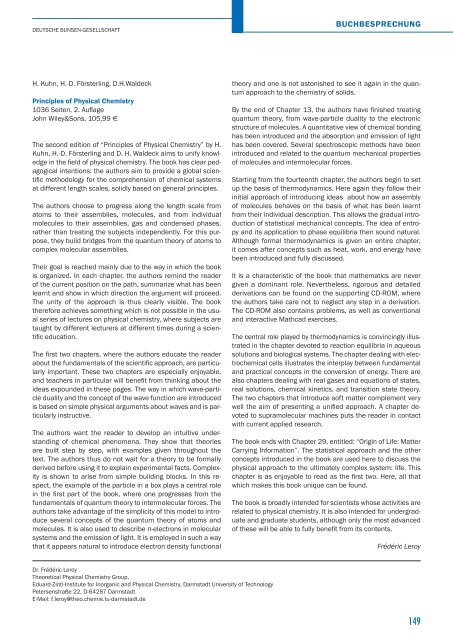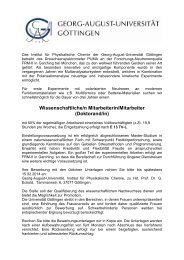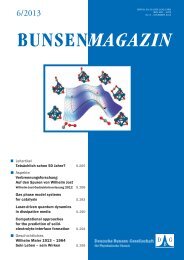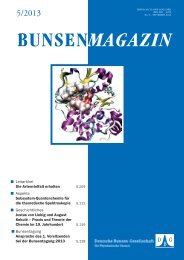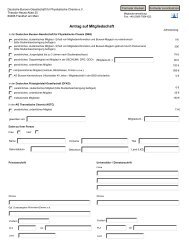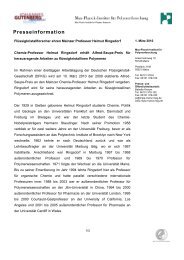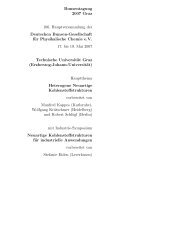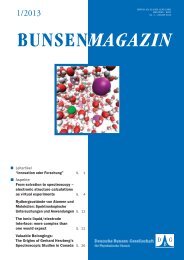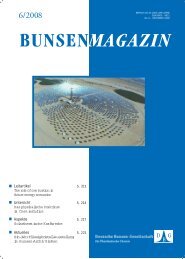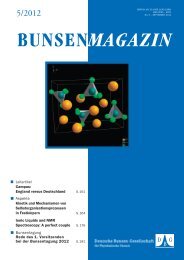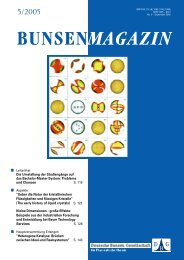BuMa_2010_04 - Deutsche Bunsengesellschaft für Physikalische ...
BuMa_2010_04 - Deutsche Bunsengesellschaft für Physikalische ...
BuMa_2010_04 - Deutsche Bunsengesellschaft für Physikalische ...
Sie wollen auch ein ePaper? Erhöhen Sie die Reichweite Ihrer Titel.
YUMPU macht aus Druck-PDFs automatisch weboptimierte ePaper, die Google liebt.
DEUTSCHE BUNSEN-GESELLSCHAFT<br />
H. Kuhn, H.-D. Försterling, D.H.Waldeck<br />
Principles of Physical Chemistry<br />
1036 Seiten, 2. Aufl age<br />
John Wiley&Sons, 105,99 €<br />
The second edition of “Principles of Physical Chemistry” by H.<br />
Kuhn, H.-D. Försterling and D. H. Waldeck aims to unify knowledge<br />
in the fi eld of physical chemistry. The book has clear pedagogical<br />
intentions: the authors aim to provide a global scientifi<br />
c methodology for the comprehension of chemical systems<br />
at different length scales, solidly based on general principles.<br />
The authors choose to progress along the length scale from<br />
atoms to their assemblies, molecules, and from individual<br />
molecules to their assemblies, gas and condensed phases,<br />
rather than treating the subjects independently. For this purpose,<br />
they build bridges from the quantum theory of atoms to<br />
complex molecular assemblies.<br />
Their goal is reached mainly due to the way in which the book<br />
is organized. In each chapter, the authors remind the reader<br />
of the current position on the path, summarize what has been<br />
learnt and show in which direction the argument will proceed.<br />
The unity of the approach is thus clearly visible. The book<br />
therefore achieves something which is not possible in the usual<br />
series of lectures on physical chemistry, where subjects are<br />
taught by different lecturers at different times during a scientifi<br />
c education.<br />
The fi rst two chapters, where the authors educate the reader<br />
about the fundamentals of the scientifi c approach, are particularly<br />
important. These two chapters are especially enjoyable,<br />
and teachers in particular will benefi t from thinking about the<br />
ideas expounded in these pages. The way in which wave-particle<br />
duality and the concept of the wave function are introduced<br />
is based on simple physical arguments about waves and is particularly<br />
instructive.<br />
The authors want the reader to develop an intuitive understanding<br />
of chemical phenomena. They show that theories<br />
are built step by step, with examples given throughout the<br />
text. The authors thus do not wait for a theory to be formally<br />
derived before using it to explain experimental facts. Complexity<br />
is shown to arise from simple building blocks. In this respect,<br />
the example of the particle in a box plays a central role<br />
in the fi rst part of the book, where one progresses from the<br />
fundamentals of quantum theory to intermolecular forces. The<br />
authors take advantage of the simplicity of this model to introduce<br />
several concepts of the quantum theory of atoms and<br />
molecules. It is also used to describe π-electrons in molecular<br />
systems and the emission of light. It is employed in such a way<br />
that it appears natural to introduce electron density functional<br />
Dr. Frédéric Leroy<br />
Theoretical Physical Chemistry Group,<br />
Eduard-Zintl-Institute for Inorganic and Physical Chemistry, Darmstadt University of Technology<br />
Petersenstraße 22, D-64287 Darmstadt<br />
E-Mail: f.leroy@theo.chemie.tu-darmstadt.de<br />
BUCHBESPRECHUNG<br />
theory and one is not astonished to see it again in the quantum<br />
approach to the chemistry of solids.<br />
By the end of Chapter 13, the authors have fi nished treating<br />
quantum theory, from wave-particle duality to the electronic<br />
structure of molecules. A quantitative view of chemical bonding<br />
has been introduced and the absorption and emission of light<br />
has been covered. Several spectroscopic methods have been<br />
introduced and related to the quantum mechanical properties<br />
of molecules and intermolecular forces.<br />
Starting from the fourteenth chapter, the authors begin to set<br />
up the basis of thermodynamics. Here again they follow their<br />
initial approach of introducing ideas about how an assembly<br />
of molecules behaves on the basis of what has been learnt<br />
from their individual description. This allows the gradual introduction<br />
of statistical mechanical concepts. The idea of entropy<br />
and its application to phase equilibria then sound natural.<br />
Although formal thermodynamics is given an entire chapter,<br />
it comes after concepts such as heat, work, and energy have<br />
been introduced and fully discussed.<br />
It is a characteristic of the book that mathematics are never<br />
given a dominant role. Nevertheless, rigorous and detailed<br />
derivations can be found on the supporting CD-ROM, where<br />
the authors take care not to neglect any step in a derivation.<br />
The CD-ROM also contains problems, as well as conventional<br />
and interactive Mathcad exercises.<br />
The central role played by thermodynamics is convincingly illustrated<br />
in the chapter devoted to reaction equilibria in aqueous<br />
solutions and biological systems. The chapter dealing with electrochemical<br />
cells illustrates the interplay between fundamental<br />
and practical concepts in the conversion of energy. There are<br />
also chapters dealing with real gases and equations of states,<br />
real solutions, chemical kinetics, and transition state theory.<br />
The two chapters that introduce soft matter complement very<br />
well the aim of presenting a unifi ed approach. A chapter devoted<br />
to supramolecular machines puts the reader in contact<br />
with current applied research.<br />
The book ends with Chapter 29, entitled: “Origin of Life: Matter<br />
Carrying Information”. The statistical approach and the other<br />
concepts introduced in the book are used here to discuss the<br />
physical approach to the ultimately complex system: life. This<br />
chapter is as enjoyable to read as the fi rst two. Here, all that<br />
which makes this book unique can be found.<br />
The book is broadly intended for scientists whose activities are<br />
related to physical chemistry. It is also intended for undergraduate<br />
and graduate students, although only the most advanced<br />
of these will be able to fully benefi t from its contents.<br />
Frédéric Leroy<br />
149


